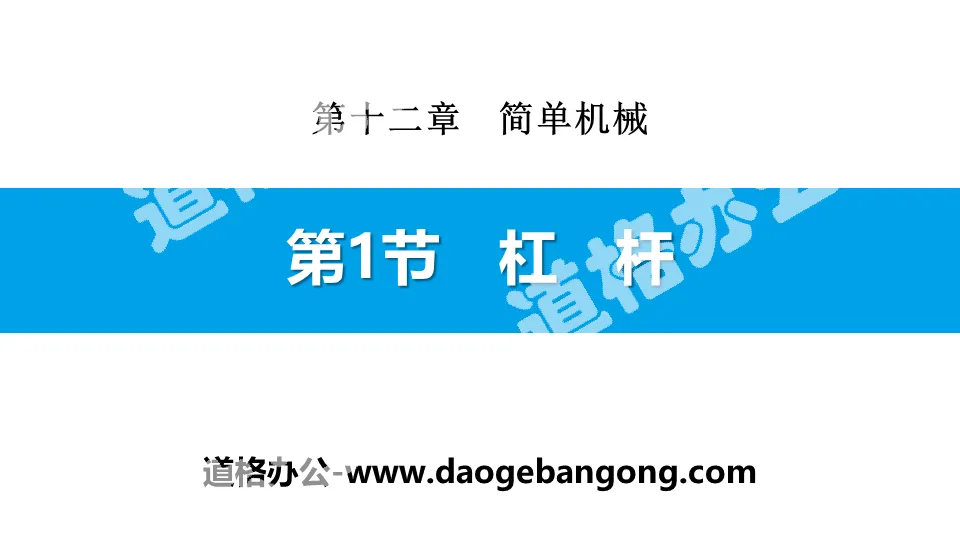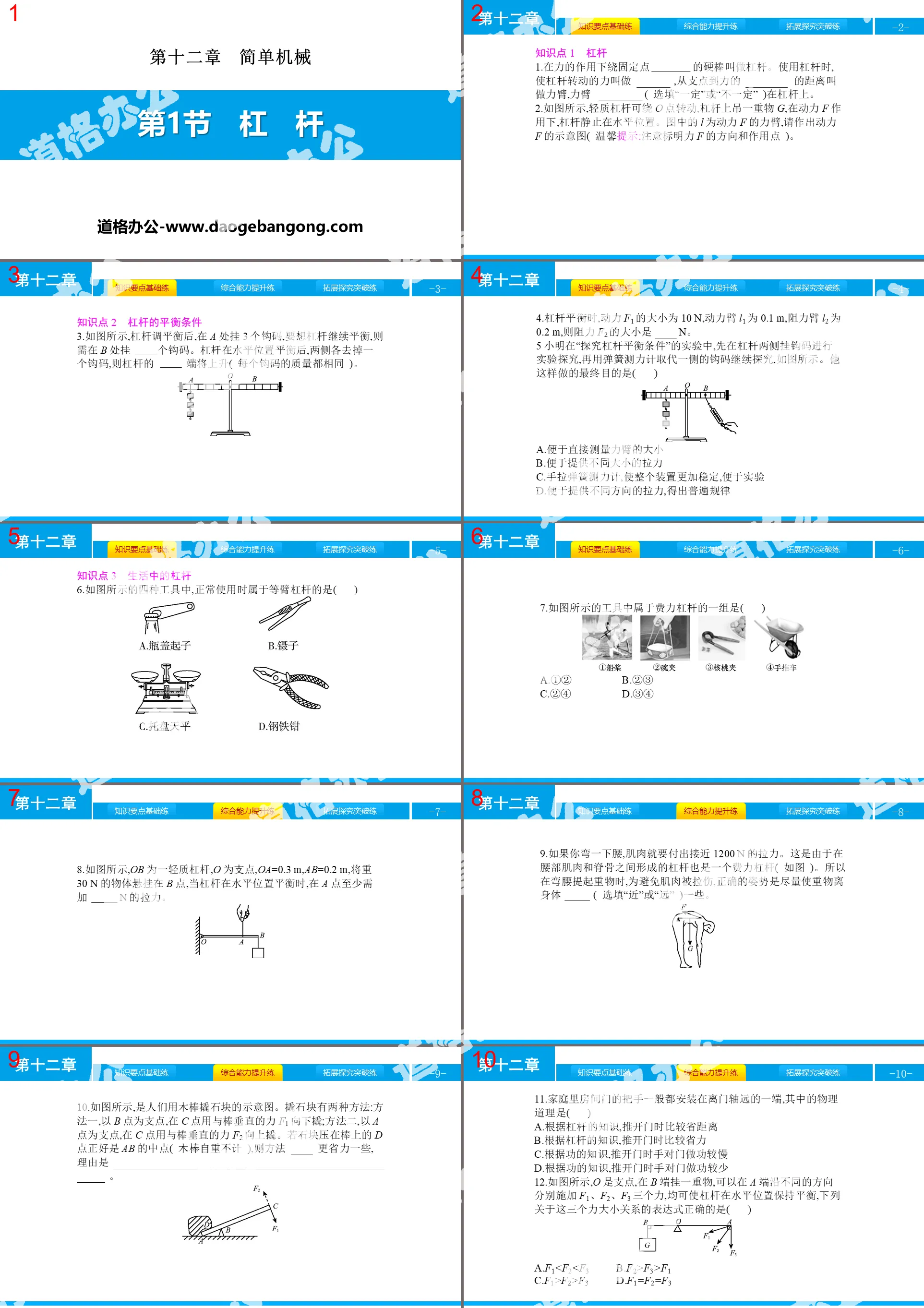People's Education Edition Physics for Grade 8, Volume 2
People's Education Edition Physics for Grade 8, Volume 1
People's Education Edition Ninth Grade Physics Complete Book
Shanghai Science Edition Ninth Grade Physics
Shanghai Science Edition 8th Grade Physics
Beijing Normal University eighth grade physics volume one
Lu Jiao Edition Ninth Grade Physics Volume 2
Beijing Normal University Ninth Grade Physics Volume 1
Lu Ke Edition High School Physics Compulsory Course One
Lu Jiao Edition Ninth Grade Physics Volume 1
Guangdong and Shanghai Edition Ninth Grade Physics Volume 1
People's Education Press High School Physics Compulsory Course II
Beijing Normal University Ninth Grade Physics Volume 2
Lu Jiao Edition Eighth Grade Physics Volume 2
Lu Jiao edition eighth grade physics volume 1
Guangdong and Shanghai Edition Ninth Grade Physics Volume 2

| Category | Format | Size |
|---|---|---|
| People's Education Edition Physics for Grade 8, Volume 2 | pptx | 6 MB |
Description
"Lever" Simple Machine PPT Download
Part One Content: Basic Knowledge Key Points
Knowledge point 1 Leverage
1. A hard rod that rotates around a fixed point under the action of force is called a lever. When using a lever, the force that causes the lever to rotate is called "power", and the distance from the fulcrum to the "line of action" of the force is called the moment arm. The moment arm is not necessarily (optional "definitely" or "not necessarily") on the lever.
2. As shown in the figure, the light lever can rotate around point O. A heavy object G is hung on the lever. Under the action of power F, the lever rests in a horizontal position. l in the picture is the moment arm of the power F. Please make a schematic diagram of the power F (warm reminder: pay attention to the direction and point of action of the force F).
Knowledge Point 2: Balance Conditions of Leverage
3. As shown in the picture, after the lever is balanced, hang 3 hooks at A. If you want the lever to continue to be balanced, you need to hang 5 hooks at B. After the lever is balanced in the horizontal position and one hook is removed from each side, the left end of the lever will rise (each hook has the same mass).
4. When the lever is balanced, the magnitude of the power F1 is 10 N, the power arm l1 is 0.1 m, and the resistance arm l2 is 0.2 m, then the magnitude of the resistance F2 is 5N.
5. In the experiment of "exploring the balance conditions of the lever", Xiao Ming first conducted an experimental investigation on the hook codes on both sides of the lever, and then used a spring dynamometer to replace the hook codes on one side to continue the investigation, as shown in the figure. His ultimate goal in doing this is (D)
A. Facilitates direct measurement of the size of the moment arm
B. Convenient to provide different sizes of pulling force
C. Hand-pulled spring dynamometer makes the whole device more stable and facilitates experiments
D. It is convenient to provide pulling force in different directions and draw general rules.
Knowledge point 3: Leverage in life
6. Among the four tools shown in the figure, the one that is an equal-arm lever when used normally is (C)
Leverage PPT, part 2: improvement of comprehensive capabilities
8. As shown in the figure, OB is a light lever, O is the fulcrum, OA=0.3 m, AB=0.2 m. An object weighing 30 N is suspended at point B. When the lever is balanced in the horizontal position, at point A At least 50N of pulling force is required.
9. If you bend down, your muscles will exert a pulling force of nearly 1200 N. This is due to the fact that the lever formed between the lumbar muscles and the spine is also a laborious lever (pictured). Therefore, when bending down to lift a heavy object, in order to avoid muscle strain, the correct posture is to keep the heavy object as close to the body as possible (select "near" or "far").
10. As shown in the picture, it is a schematic diagram of people using wooden sticks to pry stones. There are two ways to pry the stone: Method 1, use point B as the fulcrum, and use force F1 perpendicular to the rod to pry downward at point C; Method 2, use point A as the fulcrum, use force F2 perpendicular to the rod at point C. Pry upward. If point D where the stone presses on the rod is exactly the midpoint of AB (the dead weight of the wooden rod is not counted), then method two is more labor-saving. The reason is that the resistance and resistance arm of method two are equal to method one, and the power arm of method two is longer.
11. The door handle of a room in a home is usually installed at the end far away from the door axis. The physical principle is (B)
A. Based on the knowledge of levers, it saves distance when pushing the door open.
B. Based on the knowledge of levers, it is easier to push the door open
C. According to the knowledge of work, when pushing the door open, the work done by the hand on the door is slower
D. According to the knowledge of work, when pushing the door open, the hand does less work on the door.
12. As shown in the figure, O is the fulcrum. Hang a weight on end B. You can apply three forces F1, F2, and F3 in different directions on end A, which can keep the lever balanced in the horizontal position. The following is about this. The correct expression of the relationship between the three forces is (C)
A.F1
C.F1>F2>F3D.F1=F2=F3
Leverage PPT, the third part: expansion, exploration and breakthrough
16. As shown in the figure, a lightweight lever OA with a length of 1.2 m can rotate around a fixed point O, and an object weighing 60 N is suspended at point C (it is known that AB=BC=CD=DO).
(1) If a vertical upward force is used at point B to balance the lever in a horizontal position, find the magnitude of this force;
(2) If a force is applied at point A to make the lever horizontally balanced, student A thinks that the lever must be a labor-saving lever, and student B thinks that the lever may be a labor-saving lever. Which classmate's opinion do you agree with and why?
Solution: (1) OA=1.2 m, AB=BC=CD=DO, then the power arm
OB=3/4OA=3/4×1.2 m=0.9 m
Resistance arm OC=1/2OA=1/2×1.2 m=0.6 m
From the equilibrium condition of leverage, we can get, F×OB=G×OC
That is, F×0.9 m=60 N×0.6 m
So F=40 N
(2) If the direction of the force exerted at point A is different, the size of the moment arm is different, and the size relationship between the power arm and the resistance arm cannot be determined. Therefore, the lever may be an equal-arm lever, a labor-saving lever, or a Effortless leverage. Therefore, Student B’s view is correct.
Keywords: Free download of PPT courseware for the second volume of eighth-grade physics from the People's Education Press, download of lever PPT, download of simple machine PPT, .PPT format;
For more information about the "Lever of Simple Machinery" PPT courseware, please click the "Lever of Simple Machinery ppt ppt" tab.
"Pulley" Simple Machine PPT Download:
"Pulley" Simple Machine PPT Download Part One: Basic Knowledge Points Knowledge Point 1 Fixed Pulley and Moving Pulley 1. In order to promote the spirit of patriotism, many schools in Hefei City will hold flag-raising ceremonies on Monday. The picture shows the scene during a flag-raising ceremony at a school. Flagpole top...
"Integration of this Chapter" Simple Machinery PPT:
"Integration of this Chapter" Simple Machinery PPT High School Entrance Examination Focus Experience 1. (2018 Zhejiang Jinhua High School Entrance Examination) As shown in the figure, a homogeneous lever with uniform scales is used to conduct an experiment on lever balance conditions (each hook weight is 0.5 N). The following statements are correct is ( ) It can be seen from the picture in the question that the right end of the lever...
"Mechanical Efficiency" Simple Machinery PPT Download:
"Mechanical Efficiency" Simple Machinery PPT Download Part One: Knowledge Management 1. Useful work, extra work and total work Definition: (1) The work that must be done to achieve a certain purpose is called _____; (2) The work that we do not need but have to do is called _____..
File Info
Update Time: 2024-11-22
This template belongs to Physics courseware People's Education Edition Physics for Grade 8, Volume 2 industry PPT template
"Lever" Simple Machine PPT Download Simple campus recruitment activity planning plan summary enterprise and institution recruitment publicity lecture PPT template is a general PPT template for business post competition provided by the manuscript PPT, simple campus recruitment activity planning plan summary enterprise and institution recruitment promotion Lecture PPT template, you can edit and modify the text and pictures in the source file by downloading the source file. If you want more exquisite business PPT templates, you can come to grid resource. Doug resource PPT, massive PPT template slide material download, we only make high-quality PPT templates!
Tips: If you open the template and feel that it is not suitable for all your needs, you can search for related content "Lever" Simple Machine PPT Download is enough.
How to use the Windows system template
Directly decompress the file and use it with office or wps
How to use the Mac system template
Directly decompress the file and use it Office or wps can be used
Related reading
For more detailed PPT-related tutorials and font tutorials, you can view: Click to see
How to create a high-quality technological sense PPT? 4 ways to share the bottom of the box
Notice
Do not download in WeChat, Zhihu, QQ, built-in browsers, please use mobile browsers to download! If you are a mobile phone user, please download it on your computer!
1. The manuscript PPT is only for study and reference, please delete it 24 hours after downloading.
2. If the resource involves your legitimate rights and interests, delete it immediately.
3. Contact information: service@daogebangong.com
"Lever" Simple Machine PPT Download, due to usage restrictions, it is only for personal study and reference use. For commercial use, please go to the relevant official website for authorization.
(Personal non-commercial use refers to the use of this font to complete the display of personal works, including but not limited to the design of personal papers, resumes, etc.)
Preview










